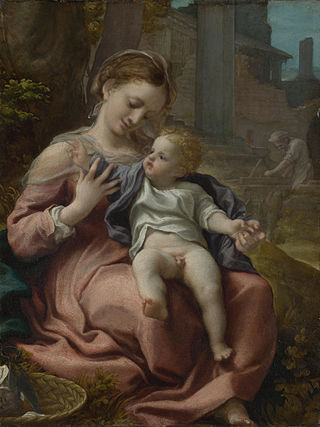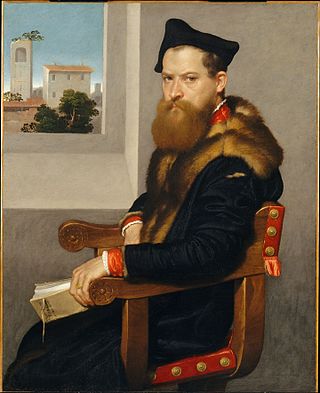The Salimbeni Prize is awarded by the Fondazione Salimbeni per le Arti Figurative of San Severino Marche to honour excellence in the writing of art history on an Italian subject. The Premio Salimbeni was established in 1983.

Girolamo Francesco Maria Mazzola, also known as Francesco Mazzola or, more commonly, as Parmigianino, was an Italian Mannerist painter and printmaker active in Florence, Rome, Bologna, and his native city of Parma. His work is characterized by a "refined sensuality" and often elongation of forms and includes Vision of Saint Jerome (1527) and the iconic if somewhat anomalous Madonna with the Long Neck (1534), and he remains the best known artist of the first generation whose whole careers fall into the Mannerist period.

Antonio Mancini was an Italian painter.

Pietro Tenerani was an Italian sculptor of the Neoclassic style.

Emilio Scanavino was an Italian painter and sculptor.

Antea is a painting by the Italian Mannerist artist Parmigianino. The painting is in the collection of the Museum of Capodimonte in Naples.

Portrait of Lorenzo Cybo (1524) is a painting by the Italian late Renaissance artist Parmigianino. It is housed in the National Gallery of Denmark, in Copenhagen.

Self-Portrait in a Convex Mirror is a painting by the Italian late Renaissance artist Parmigianino. It is housed in the Kunsthistorisches Museum, Vienna, Austria.

Turkish Slave, also called Portrait of a Young Woman, is a painting by the Italian Mannerist artist Parmigianino. The painting was executed around 1533. It is housed in the Galleria nazionale di Parma.

The Circumcision, a painting by the Italian Mannerist artist Parmigianino of the common subject of the circumcision of Jesus, was executed around 1523 and is now in the Detroit Institute of Arts, Michigan, United States.

Portrait of Pier Maria Rossi di San Secondo is a painting by the Italian Mannerist artist Parmigianino, executed around 1535–1539 and housed in the Museo del Prado, Madrid, Spain. The subject was Count of San Secondo, and the painting forms a pair with a group portrait of his Countess and their children, Portrait of Camilla Gonzaga and Her Three Sons, although the latter is not unanimously attributed to Parmigianino.

Portrait of Camilla Gonzaga and Her Three Sons is a painting attributed to the Italian Mannerist artist Parmigianino and his workshop, executed c. 1539-1540. It is housed in the Museo del Prado, in Madrid. It forms a pair with another painting in the Prado, the Portrait of Pier Maria Rossi di San Secondo, Camilla's husband, a painting which is unanimously assigned to Parmigianino.

The Vision of Saint Jerome of The Madonna and Child with Saints is a painting by the Italian Mannerist artist Parmigianino, executed in 1526–1527. It is in the collection of the National Gallery, in London.

The Madonna and Child with Sts Jerome and Mary Magdalen (The Day) is an oil on canvas painting by the Italian Renaissance artist Correggio dating from around 1528 and housed in the Galleria Nazionale of Parma, Italy.

The Madonna of the Basket or the Madonna della Cesta is a painting of c. 1524 by Antonio da Correggio in the National Gallery, London. While it is a Mannerist painting of the Virgin Mary and the Baby Jesus, Correggio included naturalist touches in his composition, like the sewing basket that gives the painting its name.

Pablo Echaurren is an Italian painter, comics artist and writer.

The Portrait of Bartolomeo Bonghi is an oil on canvas portrait by Italian artist Giovanni Battista Moroni, created in 1553. It is held at the Metropolitan Museum of Art, in New York. It depicts Bartolomeo Bonghi, a 16th-century Italian legal scholar. The portrait presents its subject as he was in life; a man of wealth and status. The buildings seen in the top left-hand corner of the painting identify the site of the portrait's sitting as Bergamo in Lombardy.

Portrait of a Young Man is an oil on panel painting by Parmigianino, executed c. 1530, now in the Uffizi in Florence, whose collection it entered on 27 October 1682. Three copies survive in the Museo di Capodimonte, Rome's Accademia di San Luca and the Galleria nazionale di Parma.

Portrait of a Man in a Red Beret or Self-Portrait in a Red Beret is an oil on paper painting attributed to Parmigianino or Michelangelo Anselmi, executed c. 1540. It is held in the collection of the National Gallery of Parma.

The Portrait of a Man Holding a Letter, also known as The Lawyer, is an oil on canvas painting by Italian painter Giovanni Battista Moroni, from 1570-1572. It is held at the National Gallery, in London. It is considered one of the most representative paintings of the artist's maturity.


















